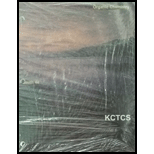
Concept explainers
(a)
Interpretation: The two possible resonance structures for the radical formed by the homolysis of indicated bond in propene are to be drawn.
Concept introduction: In
Resonance is the delocalisation of
(b)
Interpretation: The half-headed curved arrows are to be used to illustrate the conversion of one resonance structure to other.
Concept introduction: Curved arrows aid in determining the movement and flow of electrons in the reaction. The electrons that take part in the
Half headed arrows are used to show the flow of single electrons, while the full headed arrow shows the movement of electron pairs.
(c)
Interpretation: The structure of the resonance hybrid is to be drawn.
Concept introduction: Resonance is the delocalisation of
Want to see the full answer?
Check out a sample textbook solution
Chapter 6 Solutions
KCTCS Organic Chemistry Value Edition (Looseleaf) - Text Only
- Write an equation to show the proton transfer between each alkene or cycloalkene and HCl. Where two carbocations are possible, show each. (a) CH,CH,CH=CHCH, (b) 2-Pentene Cyclohexenearrow_forwardDraw the organic product formed when the following compounds undergo a substitution reaction:(a) acetic and 1-hexanol; (b) propanoic acid and dimethylamine; (c) ethanoic acid and dimethylamine.arrow_forwardThe foul odor of rancid butter is caused by butyric acid, CH3CH2CH2CO2H.(a) Draw the Lewis structure and determine the oxidation number and hybridization for each carbon atom in the molecule.(b) The esters formed from butyric acid are pleasant-smelling compounds found in fruits and used in perfumes. Draw the Lewis structure for the ester formed from the reaction of butyric acid with 2-propanol.arrow_forward
- 4. Write the formula and name for the product when cyclopentene reacts with (a) Cl2(b) HBr(c) H2, Pt (d) H2O, H+arrow_forwardDraw the organic product formed when the following compounds undergo a substitution reaction: (a) acetic acid and methylamine; (b) butanoic acid and 2-propanol; (c) formic acid and 2-methyl-1-propanol.arrow_forwardTRUE OR FALSE (a) Both ethylene and acetylene are planar molecules. (b) An alkene in which each carbon of the double bond has two different groups bonded to it will show cis-trans isomerism. (c) Cis-trans isomers have the same molecular formula but a different connectivity of their atoms. (d) Cis-2-butene and trans -2-butene can be interconverted by rotation about the carbon–carbon double bond. (e) Cis-trans isomerism is possible only among appropriately substituted alkenes. (f) Both 2-hexene and 3-hexene can exist as pairs of cis-trans isomers. (g) Cyclohexene can exist as a pair of cis-trans isomers. (h) 1-Chloropropene can exist as a pair of cis-trans isomers.arrow_forward
- Indicate whether each statement is true or false. (a) Pentanehas a higher molar mass than hexane. (b) The longer the linearalkyl chain for straight-chain hydrocarbons, the higherthe boiling point. (c) The local geometry around the alkynegroup is linear. (d) Propane has two structural isomers.arrow_forward(a) Draw the condensed structural formulas for the cis andtrans isomers of 2-pentene. (b) Can cyclopentene exhibitcis–trans isomerism? Explain. (c) Does 1-pentyne haveenantiomers? Explain.arrow_forward(i) Draw the structural formula of compounds L, M, N and P (ii) Name the type of chemical reaction for the formation of compound N.arrow_forward
- In each of the following reactions, two possible organic products can be formed. Draw both organic products in each case and then circle the one formed in greatest quantity in each case. HC (a) 1) NaH, 2) acid (b) CH,CH,OH (c) CH,CH,OH NH2 (d) Oarrow_forwardIndicate whether each statement is true or false. (a) Twogeometric isomers of pentane are n-pentane and neopentane.(b) Alkenes can have cis and trans isomers around theCC double bond. (c) Alkynes can have cis and trans isomersaround the CC triple bond.arrow_forwardQuestion: In an organic chemistry laboratory, a student is performing a reaction to synthesize a compound. The reaction involves the conversion of an alcohol into an alkene using a dehydration process. The student chooses to use concentrated sulfuric acid (H2SO4) as the catalyst for this reaction. However, during the reaction, the student notices that another product is formed along with the desired alkene. (a) What is the likely identity of the unexpected product formed during the reaction? Explain your answer. (b) Provide a plausible explanation for the formation of the unexpected product and suggest a modification to the reaction conditions that would favor the desired alkene as the major product.arrow_forward
 ChemistryChemistryISBN:9781305957404Author:Steven S. Zumdahl, Susan A. Zumdahl, Donald J. DeCostePublisher:Cengage Learning
ChemistryChemistryISBN:9781305957404Author:Steven S. Zumdahl, Susan A. Zumdahl, Donald J. DeCostePublisher:Cengage Learning ChemistryChemistryISBN:9781259911156Author:Raymond Chang Dr., Jason Overby ProfessorPublisher:McGraw-Hill Education
ChemistryChemistryISBN:9781259911156Author:Raymond Chang Dr., Jason Overby ProfessorPublisher:McGraw-Hill Education Principles of Instrumental AnalysisChemistryISBN:9781305577213Author:Douglas A. Skoog, F. James Holler, Stanley R. CrouchPublisher:Cengage Learning
Principles of Instrumental AnalysisChemistryISBN:9781305577213Author:Douglas A. Skoog, F. James Holler, Stanley R. CrouchPublisher:Cengage Learning Organic ChemistryChemistryISBN:9780078021558Author:Janice Gorzynski Smith Dr.Publisher:McGraw-Hill Education
Organic ChemistryChemistryISBN:9780078021558Author:Janice Gorzynski Smith Dr.Publisher:McGraw-Hill Education Chemistry: Principles and ReactionsChemistryISBN:9781305079373Author:William L. Masterton, Cecile N. HurleyPublisher:Cengage Learning
Chemistry: Principles and ReactionsChemistryISBN:9781305079373Author:William L. Masterton, Cecile N. HurleyPublisher:Cengage Learning Elementary Principles of Chemical Processes, Bind...ChemistryISBN:9781118431221Author:Richard M. Felder, Ronald W. Rousseau, Lisa G. BullardPublisher:WILEY
Elementary Principles of Chemical Processes, Bind...ChemistryISBN:9781118431221Author:Richard M. Felder, Ronald W. Rousseau, Lisa G. BullardPublisher:WILEY





